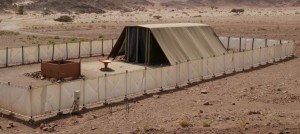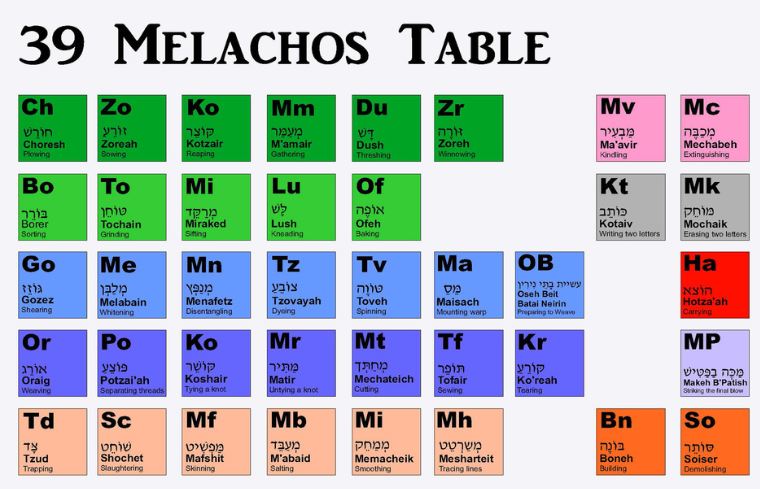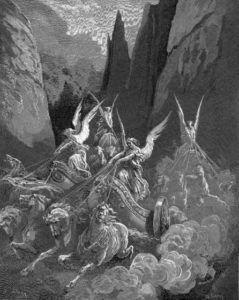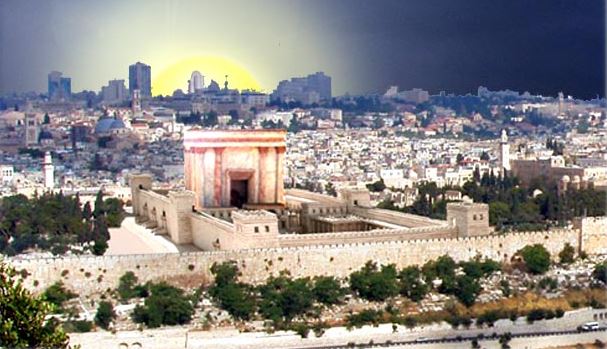On Yom Kippur we take upon ourselves five afflictions, as taught in the Mishnah: abstaining from eating and drinking, bathing, anointing with oils, wearing shoes, and sexual intimacy (Yoma 8:1). Rabbi Ovadiah of Bartenura (c. 1445-1515) comments, as the Sages explain, that these prohibitions are derived from the five times that the Torah speaks of afflicting one’s soul on Yom Kippur. The number five is most significant when it comes to Yom Kippur. The Ba’al HaTurim (Rabbi Yakov ben Asher, c. 1269-1343) comments on Leviticus 16:14 that the five services performed in the Temple on Yom Kippur parallel the five prayer services that we recite on Yom Kippur (Arvit, Shacharit, Mussaf, Minchah, Neilah), as well as the five times that the Kohen Gadol would immerse in the mikveh, and the five souls of a person which are purified on this day. (For an explanation of these five souls, see A Mystical Map of Your Soul.)
Tag Archives: Yom Kippur
A Mystical Map of Your Soul
This week, outside of Israel, we read the parasha of Acharei Mot. (In Israel, since Pesach is seven days and finished last Friday, Acharei Mot was read on Shabbat and this week the following parasha, Kedoshim, is read. For the next few months, the weekly parasha read in the Diaspora will be different than that read in Israel.) In Acharei Mot, we are commanded:
And any man of the House of Israel or of the foreigner that lives among them, who eats any blood, I will set My countenance upon the soul who eats the blood, and I will cut him off from among his people. For the soul of the flesh is in the blood, and I have therefore given it to you [to be placed] upon the altar, to atone for your souls. For it is the blood that atones for the soul. (Leviticus 17:10-11)
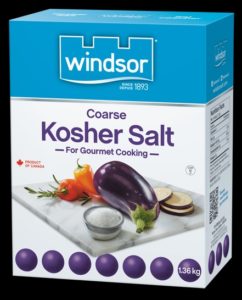
Many recipes call for the use of “kosher salt”. Chefs like it because the larger grains allow them to season their meals more precisely. Jews use koshering salt to remove the tiniest drops of blood that may have remained after draining.
The Jewish people are absolutely forbidden from consuming any kind of blood, whether in a juicy steak or even the tiniest drop inside an egg. It is quite ironic that one of the most disgusting anti-Semitic accusations thrown upon the Jews is that Jews, God forbid, consume the blood of children. (It is all the more ironic that this “blood libel” originates among Catholics who, when taking communion, believe they are drinking the blood of Jesus—who was a Jew!) In reality, Jews obsess over ensuring that we consume no blood whatsoever, and one of the requirements of kosher meat is that all of the blood has been completely removed.
The Torah explains that we should not consume blood because nefesh habasar b’dam hi, the “soul of the flesh is in the blood”. If we eat meat, it is in order to obtain the nutrients in the flesh, not to absorb the spirit of the animal. The animal’s soul is, as the Torah commands, to be placed “upon the altar”. The Kabbalists explain that by doing so, the soul of the animal is allowed to return to the spiritual worlds from which it originates.
In precisely balanced language, the verses cited above state that a Jew who consumes any blood within which is soul, nefesh, will be “cut off” from his nation, and God will personally set His wrath upon that Jewish soul, nefesh. The same word is used to refer to the soul of the Jew and that of the animal. People sometimes forget that animals, too, have souls, and it is forbidden to harm animals in any way.
Having said that, there is of course a great difference between the soul of an animal and the soul of a human. In fact, we find in the Tanakh that five different words are used to refer to the soul. Our Sages explain that a person actually has five souls, or more accurately, five parts or levels to their soul. (The Ba’al HaTurim, Rabbi Yakov ben Asher [1269-1343], states that the five prayer services of Yom Kippur, and the five times that the Kohen Gadol would immerse in the mikveh that day, is in order to purify all five souls; see his commentary on this week’s parasha, Leviticus 16:14.) These five souls are in ascending order, and correspond to the spiritual universes of Creation and to the divine Sefirot. Each soul is itself made up of even smaller, intertwining parts. Understanding the soul and its dynamics is a central part of Jewish mysticism, and what follows is a brief overview of that spiritual map.
The First Three Souls
 The first and lowest of the souls is the nefesh. As we have already seen, this soul is associated with the blood, and is the “life force” of a living organism. Above that is the soul called ruach, literally “wind” or “spirit”. We find this term right at the beginning of the Torah (Genesis 1:2) in referring to the Spirit of God (Ruach Elohim) and in many other places to refer to the souls of great people, such as Joshua (Numbers 27:18). Above that is the neshamah, literally “breath”, which we are first introduced to during the creation of Adam, where God breathes a nishmat chayim, “soul of life” into the first civilized man (Genesis 2:7).
The first and lowest of the souls is the nefesh. As we have already seen, this soul is associated with the blood, and is the “life force” of a living organism. Above that is the soul called ruach, literally “wind” or “spirit”. We find this term right at the beginning of the Torah (Genesis 1:2) in referring to the Spirit of God (Ruach Elohim) and in many other places to refer to the souls of great people, such as Joshua (Numbers 27:18). Above that is the neshamah, literally “breath”, which we are first introduced to during the creation of Adam, where God breathes a nishmat chayim, “soul of life” into the first civilized man (Genesis 2:7).
These first three souls—nefesh, ruach, and neshamah; often abbreviated as naran—are spoken of widely across Jewish holy texts, from the Tanakh through the Talmud and the Zohar. For example, the Talmud (Niddah 31a) states how there are three partners in the creation of a person: the father is the primary source of five “white” things (bones, nerves, nails, brain, eyeball), the mother is the primary source of five “red” things (blood, skin, flesh, hair, iris), and God gives ten things, including the ruach and neshamah. (The nefesh presumably goes together with the blood from the mother.)
The Zohar (I, 205b-206a) elaborates that the neshamah is greater than the ruach, which is greater than the nefesh, and that a person only accesses higher levels of their soul if they are worthy. Sinners do not have access to their neshamas at all. They are just living nefesh, like animals. Based on this, the Zohar has a unique perspective on Genesis 7:22-23:
All in whose nostrils was the breath of the spirit of life [nishmat ruach], whatsoever was in the dry land, died. And He blotted out every living substance which was upon the face of the ground, both man, and cattle, and creeping thing, and fowl of the sky; and they were blotted out from the earth; and Noah alone was left, and they that were with him in the ark.
The Zohar sees these two verses as distinct. First, all those people who did merit a ruach and neshamah (meaning they weren’t completely sinful and didn’t deserve to perish in the Flood) died of natural causes. Only after this did God “blot out” all that remained, including animals and people who were so sinful they were essentially like animals, bearing only a nefesh.
With these three souls in mind, many aspects of life can be better understood. For example, when one is asleep only the nefesh remains in the body (to keep it alive), while the higher souls may migrate. This is why a sleeping body is unconscious and likened to a corpse, and why sometimes dreams can be prophetic, as the higher souls may be accessing information from the Heavens, or through interaction with other souls.
Another intriguing example is from Ibn Ezra (Rabbi Abraham ben Meir ibn Ezra, 1089-1167) who relates the three souls to three major purposes of sexual intercourse. The first and simplest is for procreation, something that even animals do, and naturally corresponds to nefesh. The second is for good health, corresponding to ruach. The third is for love and intimacy, fusing the souls of husband and wife, corresponding to the neshamah.
In addition to naran, the Zohar sometimes speaks of additional, even higher souls, such as “nefesh of Atzilut” and “neshamah of Aba and Ima” (see II, 94b). To make sense of these, we must turn to the Arizal.
Earning Your Higher Souls
In multiple places, Rabbi Chaim Vital (1543-1620), the primary disciple of the Arizal (Rabbi Isaac Luria, 1534-1572) and the one who recorded the bulk of his teachings, describes the anatomy of the soul (see, for example, the first passages of Sha’ar HaGilgulim or Derush Igulim v’Yosher 3 in Etz Chaim). At birth, a baby only contains a full nefesh. As the Torah states, the nefesh is in the blood, and the Arizal adds that since the liver filters blood and is full of it, it is the organ most associated with nefesh. By the age of bar or bat mizvah, a person now has the ability to fully access their ruach. The organ of ruach is the heart (also stated in the Zohar, III, 29b, Raya Mehemna), associated with one’s drives, and both inclinations, the yetzer hatov and the yetzer hara. Only at age 20 does the neshamah become fully available (in most cases). The neshamah is housed in the brain, and is associated with the mind.
Today, we know how scientifically precise those statements are. For example, at any given time the liver (the body’s largest internal organ) contains about 10% of the body’s blood volume, and filters about a quarter of all blood each minute. As well, we know today that the majority of the brain’s development ends around age 20 (though minor changes continue for at least another decade, if not longer). It therefore isn’t surprising that teenagers are so good at making bad decisions. We can also understand why being a teenager is so difficult emotionally, as this is when the ruach is in full force in the heart, and one struggles with their desires and inclinations.
Reinforcing what was said in the Zohar, the Arizal taught that one does not automatically have full access to these souls, but must work on themselves and merit to attain them. Unfortunately, a great many people spend their entire lives stuck in nefesh, living very materialistic and animalistic lives, never overcoming their desires and inclinations (ruach), or achieving any kind of mental greatness (neshamah). The potential is there, though never realized.
For those who do grow ever-higher, they may be able to access even loftier soul levels: the chayah and yechidah. In the Torah, we see many places where the soul is referred to as chayah, including right at the start where God breathes a soul into Adam and makes him l’nefesh chayah (Genesis 2:7). The chayah is sometimes described as an aura. It is not housed within the body, but glows outward, and plays an important role in the interactions between people. (Conversely, some early sources speak of the chayah as being within the body, and serving as its life force. See, for example, Beresheet Rabbah 14:9.)
Above it is the highest level of soul, the yechidah, “singular one”, which connects a person directly with God. It is like a divine umbilical cord, and one who realizes it and senses it may certainly draw through it information from Above. The yechidah, too, has Scriptural basis, for example in Psalms 22:21 and 35:17 where David asks God to save his nefesh and yechidah from danger.
Souls Intertwined With Universes
In Etz Chaim, Rabbi Vital cites the Talmud (Berakhot 10a) as the source for the concept of five souls, as well as the five olamot, spiritual universes. (The mystical Sefer HaBahir adds that this is the secret of the letter hei, which has a numerical value of five.) There in the Talmud, the Sages point out how David’s Barchi Nafshi, Psalms 103-104, uses the phrase Barchi nafshi et Hashem, “May my soul bless God” five times. These, the Sages state, correspond to the five olamot, “worlds” or “universes” that David inhabited. Though the Talmud goes on to present a more physical explanation of what these worlds are, it is possible to read deeper between the lines, and the Kabbalists find allusions to five cosmic, spiritual universes, which are: Asiyah, Yetzirah, Beriah, Atzilut, and Adam Kadmon. While explaining these worlds in depth is a topic for another time, we can state that the five souls correspond to these five universes.
In fact, the Arizal teaches that one can identify the soul elevation of another by studying the colour of their aura: black is the colour of Asiyah, the lowest, physical realm which we visibly inhabit. The higher world of Yetzirah, the domain of angels and spirits, is red. Even higher is Beriah, literally “Creation”, where the very spiritual foundations of Creation exist. It is white. Above this is Atzilut, “divine emanation”, which is pure, brilliant light. These worlds, and souls, correspond to the letters of God’s Name. The final hei is Asiyah/Nefesh, the vav is Yetzirah/Ruach, the first hei is Beriah/Neshamah, the yud is Atzilut/Chayah, and the “crown” atop the yud is Adam Kadmon/Yechidah.
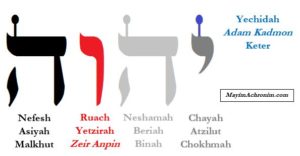
How the letters of God’s Ineffable Name relate to the five levels of soul, the five “universes”, and the Ten Sefirot. (Zeir Anpin refers to the middle six Sefirot from Chessed to Yesod.)
All of these also correspond to the major branches of Torah study. Learning Tanakh is in Asiyah, while Mishnah is in Yetzirah. Talmud is in Beriah, while Kabbalah is in Atzilut. When one learns these texts, they are putting on a spiritual “garment” for that soul level, rectifying it and elevating it further, and this garment will remain with them in the World to Come (see Sha’ar HaPesukim on Tehilim). This is the deeper meaning of Psalm 19:8, which states that God’s Torah is temimah, meshivat nafesh, is “pure and restores the soul”.
Adam Kadmon is left out of the above (and in general is made distinct from the other four universes) because that level is where one has mastered all of the Torah branches, has refined their soul to the highest degree, and is a perfectly righteous person. This level may be equated to the super-lofty soul of Nefesh d’Atzilut which we previously mentioned from the Zohar. Such a rare person is referred to as a malakh, an “angel”, and this was the case with people like Eliyahu, Yehudah, Hezekiah, and Enoch (Sha’ar HaGilgulim, ch. 39).
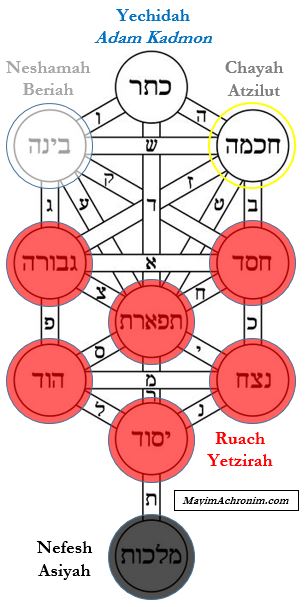
How the souls and universes relate to the “Tree of Life” which depicts the 32 Paths of Creation – the 10 Sefirot and the 22 Hebrew letters.
Emptying The Universe’s Soul
In case it wasn’t complicated enough just yet, the Arizal taught that each of the five souls is itself composed of five souls. So, within the nefesh, ruach, neshamah, chayah, and yechidah (abbreviated as naran chai) there is an inner nefesh, ruach, neshamah, chayah, and yechidah! That makes 25 smaller parts to the soul. Furthermore, each of these parts is composed of 613 sparks corresponding to the 613 mitzvot. Each of those sparks is further composed of 600,000 even smaller sparks. Multiplying them all together, we get 9.195 billion sparks.
In the same place where he writes this (Sha’ar HaGilgulim, ch. 11), Rabbi Vital explains that all of these sparks were contained within Adam. We may assume that it probably isn’t the case that each person has 9 billion or more sparks, but that Adam’s original soul divided up into so many sparks. Since it is said that in the same way all people are physical descendants of Adam, they are also his spiritual descendants, we might conclude that the world should expect to have a population of up to 9.195 billion people. Interestingly, demographers are currently predicting that Earth’s population will actually top out around 9 billion, and will then start to decline. This prediction is quite amazing in light of one famous Talmudic teaching:
In Yevamot 62a, the Sages state that Mashiach will not come until all souls are born. They describe a Heavenly repository of souls called Guf, literally “body”. Only when Guf is empty can Mashiach arrive. The Guf may be mystically referring to that first “body” of Adam which contained all souls within it. Once all of those sparks are born, all souls from the beginning of time will be alive simultaneously so that everyone can witness the tremendous Final Redemption. It appears we are inching ever closer to that moment.
The above essay is adapted from Garments of Light, Volume Three.
Get the book here!
For more about soul dynamics, see the following:
Secrets of the Mishkan
This week’s parasha, Terumah, begins with God’s command for the Israelites to build a Mishkan, an Earthly “dwelling place” for the Divine. God tells Moses (Exodus 25:2-8):
Speak to the children of Israel, and have them take for Me an offering; from every person whose heart inspires him to generosity, you shall take My offering. And this is the offering that you shall take from them: gold, silver, and copper; blue, purple, and crimson wool; linen and goat hair; ram skins dyed red, tachash skins, and acacia wood; oil for lighting, spices for the anointing oil and for the incense; shoham stones and filling stones for the ephod and for the choshen. And they shall make Me a sanctuary and I will dwell in their midst…
God requests that each person donate as much as they wish to construct a Holy Tabernacle. He concludes by stating that when the sanctuary is built, He shall dwell among them. The Sages famously point out that the Torah does not say that God will dwell in it, but in them. The sanctuary was not a literal abode for the Infinite God—that’s impossible. Rather, it is a conduit between the physical and spiritual worlds, and a channel through which holiness and spirituality can imbue our planet.
In mystical texts, we learn that the Mishkan was far more than just a temple. Every piece of the Mishkan—every pillar and curtain, altar and basin, even the littlest vessel used inside of it—held tremendous significance and represented something greater in the cosmos. In fact, the whole Mishkan was a microcosm of Creation. This is the deeper reason for why the prohibitions of Shabbat are derived from the construction of the Mishkan. The passage we cited above appears one more time in the Torah, in almost the exact same wording, ten chapters later. In that passage, we read the same command for each Israelite to donate the above ingredients to build a sanctuary. The only difference is that in the second passage, the construction of the Mishkan is juxtaposed with (Exodus 35:1-2):
Moses called the whole community of the children of Israel to assemble, and he said to them: “These are the things that God commanded to make. Six days work may be done, but on the seventh day you shall have sanctity, a day of complete rest to God; whoever performs work on this day shall be put to death…”
From this clear connection, the Sages learn that the actions required to construct and maintain the Mishkan are the same ones we must abstain from on the Sabbath. There are 39 such melakhot in all. On a more mystical level, these 39 works are said to be those same actions performed by God in creating the universe! For example, the first prohibited work (see Shabbat 7:2) is zorea, “sowing”, or seeding the earth, just as we read in the account of Creation that God said (Genesis 1:11) “Let the earth bring forth grass, herb-yielding seed, and fruit-tree bearing fruit after its kind, in which its seed is found on the earth.” Perhaps the most famous prohibition, mav’ir, “lighting” a flame, parallels God’s most famous Utterance, “Let there be light” (Genesis 1:3). Such is the case with all 39 prohibited works. In this way, when a Jew rests on the seventh day from such actions, he is mirroring the Divine Who rested from these works on the original Seventh Day.
The Mishkan and the Holidays
The Zohar (II, 135a) comments on this week’s parasha that the ingredients of the Mishkan symbolize the Jewish holidays. The first ingredient is gold, and this corresponds to the first holiday of the year, Rosh Hashanah. The second ingredient, silver, corresponds to Yom Kippur. This is because silver and gold represent the two sefirot of Chessed, “kindness”, and Gevurah, “restraint”. The latter is more commonly known as Din, “judgement”. In mystical texts, silver and gold (both the metals and the colours) always represents Chessed and Gevurah. Rosh Hashanah is judgement day, which is gold, and Yom Kippur is the day of forgiveness, silver.
The third ingredient, copper, corresponds to the next holiday, Sukkot. The Zohar reminds us that on Sukkot, the Torah commands the Israelites to sacrifice a total of seventy bulls, corresponding to the seventy root nations of the world. This is why the prophet Zechariah (14:16) states that in the End of Days, representatives from all nations of the world will come to Jerusalem specifically during Sukkot to worship God together with the Jews.
The Zohar explains that copper is Sukkot because copper (at least in those days) was the main implement of war, which the gentiles use to build their chariots and fight their battles. This, the Zohar explains, is the meaning of another verse in Zechariah (6:1), which states that “…there came four chariots out from between the two mountains; and the mountains were mountains of copper.” The Zohar concludes that the Torah prescribes the sacrifices to be brought in decreasing order (thirteen on the first day, twelve on the second, eleven on the third, etc.) to weaken the drive for war among the gentile nations.
The next ingredient is the special blue dye called techelet, which corresponds to Pesach. As the Talmud (Sotah 17a) states, techelet symbolizes the sea, and the climax of the Exodus was, of course, the Splitting of the Sea. Only at this point, the Torah states, did the Israelites believe wholeheartedly in God, and his servant Moses (Exodus 14:31). The Zohar therefore states that techelet holds the very essence of faith.
Following this is the purple dye called argaman, which is Shavuot. It isn’t quite clear why the Zohar relates these two. It speaks of purple being a fusion of right and left, perhaps referring to the fact that purple (or more accurately, magenta) is a result of a mixing of red and blue. This relates to the dual nature of Shavuot, having received on that day the two parts of the Torah (Written and Oral), and later the Two Tablets, in the month whose astrological sign is the dual Gemini. There is a theme of twos, of rights and lefts coming together. We might add that Shavuot is traditionally seen as a sort of “wedding” between God and the Jewish people, with the Torah being the ketubah, and Mt. Sinai serving as the chuppah.
The sixth ingredient, tola’at shani, red or “crimson” wool, corresponds to the little-known holiday of Tu b’Av. Although the Mishnah (Ta’anit 4:8) states that on Tu b’Av the young single ladies of Israel would go out in white dresses to meet their soulmates, the Zohar suggests that they also wore crimson wool, based on another Scriptural verse (Lamentations 4:5).
Tu b’Av is actually the last holiday that the Zohar mentions. The remaining nine ingredients correspond to the nine days after Rosh Hashanah, through Yom Kippur, ie. the “Days of Repentance”. This brings up a big question: The Zohar relates the ingredients of the Mishkan to the major Torah holidays: Rosh Hashanah and Yom Kippur, and the three Pilgrimage festivals (Pesach, Shavuot, Sukkot). Naturally, it omits Chanukah, Purim, the fasts and minor holidays, which are not explicitly spoken of in the Torah. So, why does it mention Tu b’Av? Before we even begin to answer this question, we should already recognize the huge significance of Tu b’Av, strangely one of the most oft-forgotten holidays on the Jewish calendar.
Tu b’Av: a Torah Holiday
The holidays that are not explicitly commanded by God in the Torah were all instituted by future Sages. Purim was instituted by Esther and Mordechai, and first celebrated in Persia. Yet, the Talmud tells us that the majority of the Sages in the times of Esther and Mordechai initially rejected their call to establish Purim as a holiday! (See Yerushalmi, Megillah 6b-7a.) Interestingly, historians and archaeologists have not found a single Megillat Esther among the thousands of Dead Sea Scrolls and fragments, suggesting that the Jews who lived in Qumran did not commemorate Purim. Clearly, it was still a point of contention as late as two thousand years ago.
Chanukah, meanwhile, is not found in the Tanakh at all. Although two Books of Maccabees exist, the Sages did not include them in the final compilation of the Tanakh. Similarly, the later Sages of the Mishnaic and Talmudic era did not find it fit to have a separate tractate for Chanukah, even though there is a separate tractate for every other big holiday.
The fast days are not festivals, but sad memorial days instituted by the Sages to commemorate tragic events. Tu b’Shevat appears to have no Scriptural origins. Yet, Tu b’Av does. The Talmud (Ta’anit 30b) tells us that one of the historical events that we commemorate on Tu b’Av is the fact that the tribe of Benjamin was permitted to “rejoin the congregation of Israel”. In the final chapters of the Book of Judges, we read how a civil war emerged in Israel, pitting all the tribes against Benjamin because of the horrible incident where a woman was brutally raped in Gibeah. The tribe of Benjamin was subsequently cut off from Israel, with their men forbidden from marrying women of other tribes. The ban was eventually lifted on Tu b’Av. The men of Benjamin were told:
“Behold, there is a festival of God from year to year in Shiloh, which is on the north of Bethel, on the east side of the highway that goes up from Bethel to Shechem, and on the south of Lebonah.” And they commanded the children of Benjamin, saying: “Go and lie in wait in the vineyards; and see, and, behold, if the daughters of Shiloh come out to dance in the dances, then come out of the vineyards, and take every man his wife of the daughters of Shiloh, and go to the land of Benjamin…” (Judges 21:19-21)
The Tanakh is clearly describing what the Talmud says would happen on Tu b’Av, when the young ladies would go out to dance in the vineyards to find their soulmates. The exact Scriptural wording is that this day is a chag Adonai, “festival of God”. This is precisely the term used by Moses during the Exodus (Exodus 10:9), possibly referring to Pesach, or more likely to Shavuot (as Rabbeinu Bechaye comments). It is also the term used later in the Torah to describe Sukkot (Leviticus 23:39). Thus, Tu b’Av is evidently a Torah festival, too! And this is why the Zohar singles it out from all the other, “minor” holidays. It seems Tu b’Av is not so minor after all.
The Zohar concludes its passage on Terumah by saying that although we do not have the ability to offer Terumah today, and there is no Mishkan for us to build, we nonetheless have an opportunity to spiritually offer up these ingredients when we celebrate the holidays associated with them. When one wholeheartedly observes Rosh Hashanah, it is as if they offered up gold in the Heavenly Temple, and during Yom Kippur one’s soul brings up silver. Over the days of Sukkot, there is an offering of copper up Above, and on Pesach it is techelet; on Shavuot, argaman, on Tu b’Av, tola’at shani, and on the Days of Repentance the remaining ingredients. On these special days, we help to construct the Heavenly Abode. And this is all the more amazing when we remember that Jewish tradition maintains the Third Temple will not need to physically be built as were the first two, but will descend entirely whole from Heaven.


